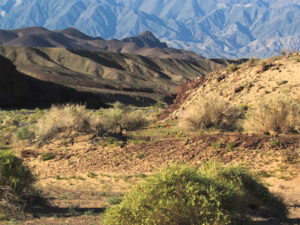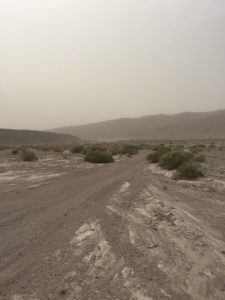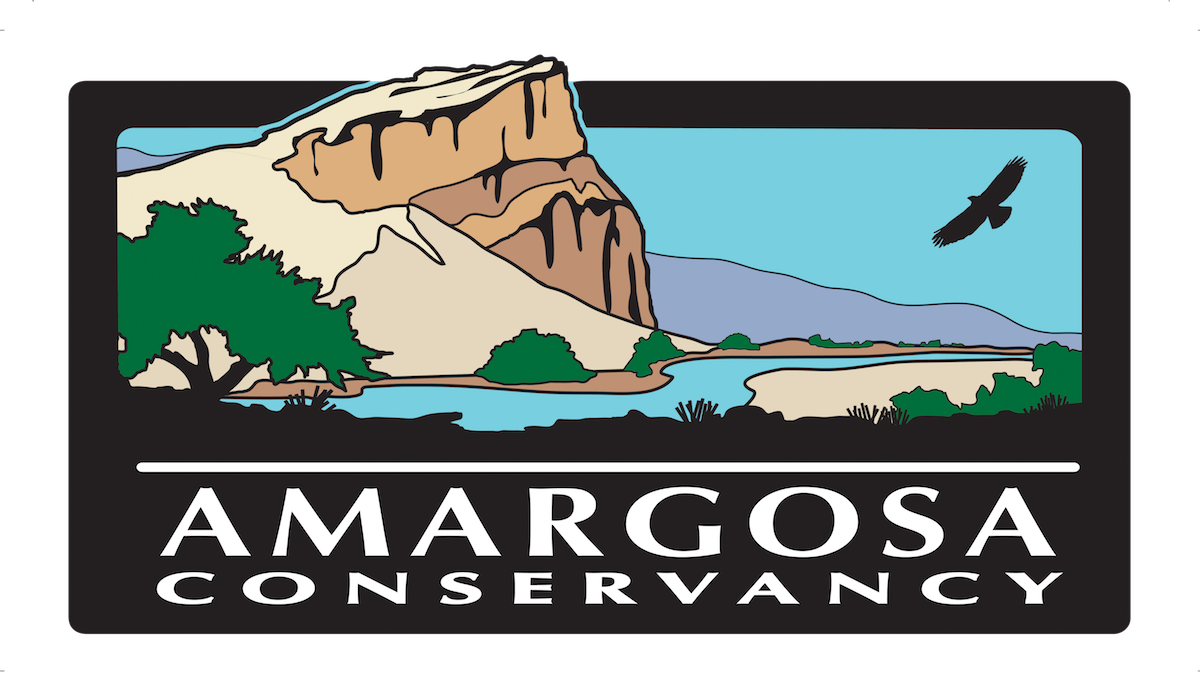After a few hectic weeks, the Amargosa Conservancy interns are getting back to their normal routine. We spent most of this week back at Sperry Wash, where we eliminated several incursions (tracks in areas where there should be no off-route travel) and also braved some vicious sandstorms.
Since Rhyan and Alison were at the Afton Canyon outreach event last Sunday (see Rhyan’s super exciting blog post for more details!) we had Monday off. On Tuesday we started our work week by driving to Sperry Wash. We spent our time working at a site where OHV riders had left the main road to access an old railroad bed. Of course, the OHV riders couldn’t make things easy for us; this section contains at least a half-dozen separate incursions, which criss-cross as they lead to the railroad bed. On Tuesday, we “planted” 29 dead shrubs at this site, and we managed to wrap up one of the incursions there.
 My long-term plans for my career involve researching and applying methods in restoration ecology. So I’ve really appreciated having the opportunity to practice vertical mulching and desert restoration here in the Amargosa Basin. I feel like the work I’m doing at Sperry Wash is really meaningful, and I’m glad to be getting experience in something that I’ll likely be devoting my career to.
My long-term plans for my career involve researching and applying methods in restoration ecology. So I’ve really appreciated having the opportunity to practice vertical mulching and desert restoration here in the Amargosa Basin. I feel like the work I’m doing at Sperry Wash is really meaningful, and I’m glad to be getting experience in something that I’ll likely be devoting my career to.
On Wednesday, we had most of the day allotted for our independent projects. Rhyan and Alison’s project is to create better maps and signs for the trail system here in the town of Shoshone. So, they spent some time on Wednesday installing mapping software on the conservancy’s computer, and learning how to use it. They also used a wood-burner to start etching arrows and words into the signs. I personally spent my morning organizing herbarium data.  I also spent a few hours after that hiking on the trails around Shoshone, and collected a handful of new specimens (shadscale, burrobush, pepperweed, and the invasive tamarisk). Links to the plants I’ve collected are at the bottom of this post. Hiking and plants are my two favorite things so this was definitely the highlight of my week.
I also spent a few hours after that hiking on the trails around Shoshone, and collected a handful of new specimens (shadscale, burrobush, pepperweed, and the invasive tamarisk). Links to the plants I’ve collected are at the bottom of this post. Hiking and plants are my two favorite things so this was definitely the highlight of my week.
Thursday we returned to our site at Sperry Wash. The site was calm and sunny when we arrived, and work went smoothly for the first hour or so. Then the wind started picking up. Strong winds did not help our attempts at vertical mulching. The dead bushes that we were trying to use often got scattered around or blown away by the gusts of wind. There also were a few instances of interns chasing after items such as gloves, hard-hats, tarps, and buckets. What really made our work challenging, however, was the dust that blew in with the wind. It blew into our eyes and ears and mouths, and was so dense that we could hardly see the canyon walls around us. We worked in these conditions for a few hours, and we somehow managed to plant another 48 bushes and wrap up a couple more incursions, but we had to head back the office early.
 According to NOAA’s National Weather Service, our region has been experiencing gusts of wind as high as 70 mph. I hadn’t really considered the possibility of being hit with sandstorms before I moved out here. It’s been a fascinating experience, and a memorable lesson in how intense the desert can be. I’m glad I’ve had the opportunity to witness it once; but, it’s not really ideal conditions to be working in, and I have an unruly amount of sand in my ears and nostrils. So, I hope I never have to endure another one of those again.
According to NOAA’s National Weather Service, our region has been experiencing gusts of wind as high as 70 mph. I hadn’t really considered the possibility of being hit with sandstorms before I moved out here. It’s been a fascinating experience, and a memorable lesson in how intense the desert can be. I’m glad I’ve had the opportunity to witness it once; but, it’s not really ideal conditions to be working in, and I have an unruly amount of sand in my ears and nostrils. So, I hope I never have to endure another one of those again.
The sandstorms continued overnight into Friday. Instead of heading back into the field into those conditions again, we decided to take a shortened day in the office. I’ll spend some time working with my herbarium, and also doing chores like cleaning our dusty picks and shovels. Although I’d normally rather be in the field, I’m glad that I’m currently not being blasted by sand. Plus this has also given me the chance to write this blog post! Thanks, sandstorm!
Until next time,
Sam S.

